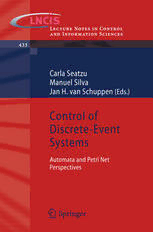Table Of ContentLecture Notes
in Control and Information Sciences 433
Editors
ProfessorDr.-Ing.ManfredThoma
InstitutfuerRegelungstechnik,UniversitätHannover,Appelstr.11,30167Hannover,
Germany
E-mail:thoma@irt.uni-hannover.de
ProfessorDr.FrankAllgöwer
InstituteforSystemsTheoryandAutomaticControl,UniversityofStuttgart,
Pfaffenwaldring9,70550Stuttgart,Germany
E-mail:allgower@ist.uni-stuttgart.de
ProfessorDr.ManfredMorari
ETH/ETLI29,Physikstr.3,8092Zürich,Switzerland
E-mail:morari@aut.ee.ethz.ch
SeriesAdvisoryBoard
P.Fleming
UniversityofSheffield,UK
P.Kokotovic
UniversityofCalifornia,SantaBarbara,CA,USA
A.B.Kurzhanski
MoscowStateUniversity,Russia
H.Kwakernaak
UniversityofTwente,Enschede,TheNetherlands
A.Rantzer
LundInstituteofTechnology,Sweden
J.N.Tsitsiklis
MIT,Cambridge,MA,USA
Forfurthervolumes:
http://www.springer.com/series/642
Carla Seatzu, Manuel Silva,
and Jan H. van Schuppen (Eds.)
Control of Discrete-Event
Systems
Automata and Petri Net Perspectives
ABC
Editors
CarlaSeatzu JanH.vanSchuppen
DepartmentofElectrical CentrumWiskunde&Informatica
andElectronicEngineering Amsterdam
UniversityofCagliari TheNetherlands
Cagliari
Italy
ManuelSilva
DepartmentofComputerScience
andSystemsEngineering
UniversityofZaragoza
Zaragoza
Spain
ISSN0170-8643 e-ISSN1610-7411
ISBN978-1-4471-4275-1 e-ISBN978-1-4471-4276-8
DOI10.1007/978-1-4471-4276-8
SpringerLondonHeidelbergNewYorkDordrecht
LibraryofCongressControlNumber:2012941741
(cid:2)c Springer-VerlagLondon2013
Thisworkissubjecttocopyright.AllrightsarereservedbythePublisher,whetherthewholeorpartof
thematerialisconcerned,specificallytherightsoftranslation,reprinting,reuseofillustrations,recitation,
broadcasting,reproductiononmicrofilmsorinanyotherphysicalway,andtransmissionorinformation
storageandretrieval,electronicadaptation,computersoftware,orbysimilarordissimilarmethodology
nowknownorhereafterdeveloped.Exemptedfromthislegalreservationarebriefexcerptsinconnection
with reviews or scholarly analysis or material supplied specifically for the purpose of being entered
and executed on a computer system, for exclusive use by the purchaser of the work. Duplication of
this publication or parts thereof is permitted only under the provisions of the Copyright Law of the
Publisher’slocation,initscurrentversion,andpermissionforusemustalwaysbeobtainedfromSpringer.
PermissionsforusemaybeobtainedthroughRightsLinkattheCopyrightClearanceCenter.Violations
areliabletoprosecutionundertherespectiveCopyrightLaw.
Theuseofgeneraldescriptivenames,registerednames,trademarks,servicemarks,etc.inthispublication
doesnotimply,evenintheabsenceofaspecificstatement,thatsuchnamesareexemptfromtherelevant
protectivelawsandregulationsandthereforefreeforgeneraluse.
Whiletheadviceandinformationinthisbookarebelievedtobetrueandaccurateatthedateofpub-
lication,neithertheauthorsnortheeditorsnorthepublishercanacceptanylegalresponsibilityforany
errorsoromissionsthatmaybemade.Thepublishermakesnowarranty,expressorimplied,withrespect
tothematerialcontainedherein.
Printedonacid-freepaper
SpringerispartofSpringerScience+BusinessMedia(www.springer.com)
Preface
Controlof discrete-eventdynamicsystems is the topicof thisbook.Theaim is to
provideanintroductiontothefield,startingatanelementarylevelandgoingtoclose
to the currentresearch front. The reader will find concepts, theorems, algorithms,
andexamples.ParticularlyaddressedtoPh.D.studentsandjuniorresearcherswork-
ingoncontrolofdiscrete-eventdynamicsystems(DEDS)and,moregenerally,on
control theory, this monograph only presumes a little background of elementary
topicsofcontroltheory.Thechaptersarealmostallbasedonlecturesofasummer
schoolforPh.D.studentsheldinJune2011inCagliari,Sardinia,Italy.
ThreerelatedmodelingformalismsofDEDSarecovered:automata,Petrinets,
andsystemsindioids.Thefirstfocusofthebookisoncontrolofdecentralizedand
ofdistributedDEDS,informallyspeakingcomposedbytheinterconnectionoftwo
ormoresubsystems.Mostengineeringsystemsarecurrentlyofthistype.Thesec-
ondfocusofthebookdealswithheavilyloadedorpopulatedDEDS,eventuallydis-
tributed,forwhichthesocalledstateexplosionproblembecomesparticularlyacute.
Therefore it becomes important to consider ‘coarse views’ obtained through flu-
idizationofthediscreteeventmodel.Thosefluidorcontinuousover-approximated
viewsofDEDSleadtospecialclassesofhybridsystems.
ControltheoryforDEDSismotivatedbytheorderingofeventsoractions.Prob-
lems of controlof DEDS arise in control engineering,computer engineering,and
sciences.AreasinwhichDEDScontrolproblemsariseincludemanufacturingsys-
tems, automated guided vehicles, logistics, aerial vehicles, underwater vehicles,
communicationnetworks,mobilephonesorchemicalengineeringsystems,butalso
software systems on computers,laptops,and readers. The researchinto controlof
DEDS,heavilyloadedornot,isthuswellmotivatedbyengineeringbutalsotheo-
reticallyquitedeep.
A brief descriptionof the bookby partsand by chaptersfollows. The first part
(nine chapters) concerns controlof automata. After a chapter on modeling of en-
gineering systems by automata (Chapter 1) there follows one with the concepts
of automata, decidability, and complexity (Chapter 2). Supervisory control of au-
tomataissummarizedfirstwithrespecttocompleteobservationsandsubsequently
withrespecttopartialobservations(Chapters3and4,respectively).Observersand
VI Preface
diagnosers for automata, in particular distributed observers, are covered in Chap-
ter5.SupervisorycontrolofdistributedDEDSisintroducedbythreespecialcases
inChapter6.Thatchapterisfollowedbyoneondistributedcontrolwithcommuni-
cation(Chapter7)andoneoncoordinationcontrol(Chapter8).Finally,Chapter9
dealswithtimedautomata.
ThesecondpartofthebookaddressesthecontrolofPetrinets.Itincludeseleven
chapters and can be seen as structured into two main parts: the first one, includ-
ingeightchapters,dealingwithdiscretePetrinets;thesecondpart,includingthree
chapters, dealing with fluid relaxations. The former eight chapters can be divided
into two blocks: the first six are devoted to untimed models, while the remaining
two are related to timed models. In particular, Chapters 10 and 11 introduce ba-
sic concepts and structural analysis techniques. Chapters 12 and 13 are related to
control.Afterconsideringsupervisorycontrolwithlanguagesspecifications(Chap-
ter 12),structuralmethodstailoredforresourceallocationproblemsarestudiedin
the following one. Chapters 14 and 15 deals with diagnosis problems, the second
oneusingnetunfolding.Petrinetsenrichedwithdifferenttemporalmetricsandse-
mantics are introduced in Chapter 16 and used in Chapter 17 for fault diagnosis,
nowon-lineovertimedmodels.
Chapters18,19and20arebasedonfluidrelaxationofDEDS.Inparticular,the
fluidorcontinuousviewsofPetrinetsareintroducedinChapter18onbothuntimed
andtimedmodels,dealingevenwithimprovementsoftherelaxationwithrespectto
theunderlyingdiscretecase.Finally,Chapters19and20aredevotedtoobservability
anddiagnosis,andcontrollabilityandcontrol,respectively.
The thirdand lastpartdealswith the modelingandcontrolof DEDSin dioids.
Adioidisamathematicalstructurewithtwooperations,usuallyreferredtoasaddi-
tionandmultiplication,wheretheformer,unlikeinstandardalgebra,isidempotent.
The most well known example for a dioid is the so-called max-plus algebra. Re-
strictedclassesoftimedDEDS,inparticulartimedeventgraphs,becomelinearin
a suitabledioidframework.Forsuchsystems,controldoesnotinvolvelogicalde-
cisions,onlychoicesregardingthetimingofevents.Theyfrequentlyappearinthe
contextofmanufacturingsystems,butalsoariseinotherengineeringareas.Chapter
21showshowtomodeltimedeventgraphsindioidframeworksandprovidesade-
tailedexamplefromtheareaofhigh-throughputscreening.Chapter22summarizes
andillustratescontrolsynthesisforsystemsindioids.
Cagliari,Italy CarlaSeatzu
Zaragoza,Spain ManuelSilva
Amsterdam,Netherlands JanH.vanSchuppen
April2012 Editors
Acknowledgements
Theeditorsthanktheauthorsofthechaptersofthisbookfortheirdedicatedefforts
to produce well readable chapters for the intended audience. They also thank the
reviewers of the book for their efforts to provide comments to the authors on the
chapters.Alistofthereviewersisprovidedelsewhereinthebook.Theythankthe
GuestEditorChristoforosN.Hadjicostisforhandlingthereviewprocessofseveral
chaptersco-authoredbyoneoftheeditors.
The European Commission is thanked for its financial support in part by the
EuropeanCommunity’sSeventhFrameworkProgrammefortheDISCProjectunder
GrantAgreementnumberINFSO-ICT-224498.TheyalsothankAlessandroGiuaas
thecoordinatoroftheDISCprojectforhisstimulationoftheeditorsforthisbook.
The authorsof Chapters 2, 3, 4, 6, and 8 acknowledgethe financialsupportby
theGACˇRgrantsP103/11/0517andP202/11/P028,andbyRVO:67985840.
TheauthorsofChapters13,18,19and20acknowledgethefinancialsupportby
theSpanishCICYTundergrant:DPI2010-20413.
Contents
PartI: Automata
1 ModellingofEngineeringPhenomenabyFiniteAutomata ......... 3
Jo¨rgRaisch
1.1 Introduction.............................................. 3
1.2 StateModelswithInputsandOutputs ........................ 5
1.2.1 MealyAutomata .................................. 5
1.2.2 MooreAutomata .................................. 10
1.3 AutomatawithControllableandUncontrollableEvents ......... 10
1.4 FiniteAutomataasApproximationsofSystemswithInfinite
StateSets ................................................ 12
1.4.1 l-CompleteApproximations......................... 14
1.4.2 ASpecialCase:StrictlyNon-anticipatingSystems...... 16
1.5 FurtherReading .......................................... 21
References..................................................... 21
2 Languages,Decidability,andComplexity ....................... 23
StefanHaarandToma´sˇMasopust
2.1 Introduction.............................................. 23
2.2 RegularLanguagesandAutomata ........................... 24
2.2.1 WordsandLanguages.............................. 24
2.2.2 RegularLanguages ................................ 25
2.2.3 Automata ........................................ 25
2.2.4 ClosurePropertiesofRegularLanguages.............. 28
2.2.5 RegularityandRecognizability ...................... 29
2.2.6 CriteriaforRegularity.............................. 29
2.2.7 Minimality ....................................... 30
2.3 ChomskyGrammars....................................... 31
2.3.1 Type0GrammarsandLanguages .................... 31
2.3.2 Type1:Context-Sensitive........................... 32
X Contents
2.3.3 Type2:Context-FreeLanguagesandPushdown
Automata ........................................ 32
2.3.4 Type3Languages ................................. 35
2.3.5 TheChomskyHierarchy............................ 35
2.4 TuringMachinesandDecidability ........................... 35
2.4.1 UniversalTuringMachine .......................... 37
2.4.2 DecidableandUndecidableProblems................. 38
2.5 ComplexityClasses ....................................... 39
2.5.1 Reduction........................................ 40
2.6 FurtherReading .......................................... 42
References..................................................... 42
3 SupervisoryControlwithCompleteObservations ................ 45
Toma´sˇMasopustandJanH.vanSchuppen
3.1 Introduction.............................................. 45
3.2 MotivationofSupervisoryControl........................... 45
3.3 ConceptsofAutomataandofLanguages...................... 47
3.4 ConceptsofControlofDiscrete-EventSystems ................ 49
3.5 ProblemofExistenceofaSupervisoryControl ................ 51
3.6 ExistenceofaSupervisoryControl .......................... 52
3.7 ImplementationofaSupervisoryControlbyaSupervisor ....... 55
3.8 ComputationofaSupervisor................................ 56
3.9 Partially-OrderedSets ..................................... 57
3.10 SupremalControllableSublanguages......................... 58
3.11 SupremalSupervision ..................................... 61
3.12 FurtherReading .......................................... 62
References..................................................... 63
4 SupervisoryControlwithPartialObservations................... 65
JanKomenda
4.1 Introduction.............................................. 65
4.2 ConceptsofSupervisoryControlwithPartialObservations ...... 66
4.2.1 ObserverAutomaton............................... 67
4.2.2 SupervisorwithPartialObservations ................. 71
4.3 ExistenceofSupervisors ................................... 71
4.4 AlgorithmforVerification of ObservabilityandAutomata
ImplementationofSupervisors .............................. 75
4.5 GeneralCaseofUnobservableSpecifications ................. 77
4.6 Algorithms............................................... 80
4.7 Extensions............................................... 83
4.8 FurtherReading .......................................... 83
References..................................................... 83
Contents XI
5 DiagnosisandAutomata...................................... 85
EricFabre
5.1 Diagnosisvs.StateEstimation .............................. 85
5.2 ObserverandDiagnoser.................................... 87
5.3 ProbabilisticObserver ..................................... 89
5.4 Diagnosability............................................ 94
5.5 ModularObservers........................................ 97
5.6 DistributedStateEstimation ................................101
5.7 ConclusionandFurtherReading.............................104
References.....................................................105
6 SupervisoryControlofDistributedDiscrete-EventSystems ........ 107
JanKomenda,Toma´sˇMasopust,andJanH.vanSchuppen
6.1 Introduction..............................................107
6.2 Motivation...............................................108
6.3 Systems .................................................109
6.4 ProblemFormulation ......................................112
6.5 DecentralizedControl–ExistenceandConstructionofaTuple
ofSupervisors............................................113
6.6 DecentralizedControl–Undecidability.......................116
6.7 DecentralizedControl–MaximalLanguages ..................117
6.8 DistributedControlofDistributedDESs ......................119
6.9 ResearchIssues...........................................122
6.10 FurtherReading ..........................................123
References.....................................................123
7 An Overview of SynchronousCommunicationfor Controlof
DecentralizedDiscrete-EventSystems .......................... 127
LaurieRicker
7.1 Introduction..............................................127
7.2 NotationandDefinitions ...................................128
7.3 State-BasedCommunicationProtocols .......................132
7.4 Event-BasedCommunicationProtocols.......................142
7.5 FurtherReading ..........................................145
References.....................................................146
8 CoordinationControlofDistributedDiscrete-EventSystems ....... 147
JanKomenda,Toma´sˇMasopust,andJanH.vanSchuppen
8.1 Introduction..............................................147
8.2 Definitions...............................................148
8.3 ProblemStatement ........................................151
8.4 CoordinationControlwithCompleteObservations:Existence ....152
8.5 CoordinationControlwithCompleteObservations:Supremal
Supervision ..............................................155
8.6 CoordinationControlwithPartialObservations:Existence.......160
XII Contents
8.7 CoordinationControlwith Partial Observations:Supremal
Supervision ..............................................163
8.8 FurtherReading ..........................................165
References.....................................................165
9 AnIntroductiontoTimedAutomata ........................... 169
Be´atriceBe´rard
9.1 MotivationandExample ...................................169
9.2 DefinitionandTimedSemantics.............................170
9.2.1 TimedTransitionSystems ..........................170
9.2.2 TheModelofTimedAutomata ......................172
9.2.3 SemanticsofTimedAutomata.......................172
9.2.4 LanguagesofTimedAutomata ......................173
9.3 NetworksofTimedAutomata...............................174
9.4 ZoneGraphofaTimedAutomaton ..........................177
9.5 RegionGraphofaTimedAutomaton.........................179
9.6 LanguageProperties.......................................182
9.6.1 ClosureProperties.................................183
9.6.2 UndecidabilityResults .............................185
9.7 FurtherReading ..........................................185
References.....................................................186
PartII: PetriNets
10 IntroductiontoPetriNets .................................... 191
MariaPaolaCabasino,AlessandroGiua,andCarlaSeatzu
10.1 Introduction..............................................191
10.2 PetriNetsandNetSystems .................................192
10.2.1 Place/TransitionNetStructure.......................192
10.2.2 MarkingandNetSystem ...........................194
10.2.3 EnablingandFiring................................194
10.3 ModelingwithPetriNets...................................197
10.4 AnalysisbyEnumeration...................................199
10.4.1 ReachabilityGraph ................................200
10.4.2 CoverabilityGraph ................................201
10.4.3 BehavioralProperties ..............................204
10.5 FurtherReading ..........................................210
References.....................................................211
11 StructuralAnalysisofPetriNets............................... 213
MariaPaolaCabasino,AlessandroGiua,andCarlaSeatzu
11.1 Introduction..............................................213
11.2 AnalysisviaStateEquation.................................214
11.3 AnalysisBasedontheIncidenceMatrix ......................216
11.3.1 InvariantVectors ..................................216
11.3.2 P-InvariantsComputation...........................218
11.3.3 ReachabilityAnalysisUsingP-Invariants..............221

